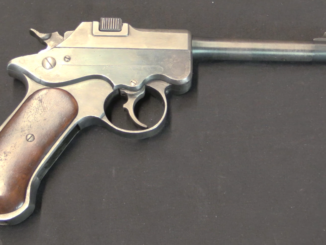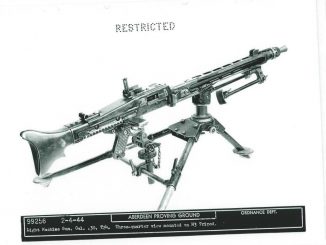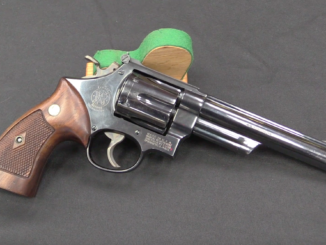The Grant Hammond .45 pistol is a gun which was too late to take part in the major 1907 US military pistol trials, and which was instead presented proactively to the military in hopes of supplementing or replacing the current issue pistol (the Remington M53 falls into this same category). Unfortunately for Mr. Hammond, his design just wasn’t good enough to pass muster (the Remington actually would have had a real shot at adoption had it been in the 1907 trials).
Hammond’s early patents were for an exceedingly complex design, which combined elements of blow-forward and long recoil operation (you can see my video on a Hammond .32 prototype), but by the time he was making the gun in .45 for trials he had simplified it considerably. As proposed to the military, it was a short-recoil mechanism with a vertically-sliding locking block. The first prototypes would actually eject their magazine automatically when it ran dry, but this feature was not like, and was removed from later production.
In total, only a handful of Hammond pistols were made. They underwent several military tests in 1917 and 1918, and proved quite accurate – but not durable or reliable enough for further consideration.




very attractive looking gun, too bad it never saw serious production
I really do like it’s looks, it resembles a Ruger .22 Mk1 somewhat. But that’s “slimmer” because the barrel doesn’t have to move.
_
/ |_
_/
That wee illustration didn’t work, script editing. It was supposed to illustrate a ledge, as per the M53’s locking ledge on the frame. Which I was going to use to describe a bolt idea, using a rectangle with a diagonal line running from it’s upper right apex to it’s lower left one. Anyway to cut that probably lenthy description short, in order the barrel doesn’t have to move I essentially thought have the bolt act as the slide and bolt on the M53 to delay opening- A carrier and bolt, operating as the bolt on the Hammond I.e Popping out the back. If the M53’s slide continues rearward after gaining it’s initial momentum, in theory so should the bolt albeit quicker. Shorten the barrel perhaps, Luger length.
I’ll briefly expand on the type of bolt I made reference to above, just to share another possible layout for achieving the desired Pedersen affect alluded to as envisaged. Imagine said rectangle, as two separate right triangle type shapes upon each other. The lower ones rear point is cut off vertically about 5mm back, to engage the frame ledge. The upper ones rear bottom point is cut off horizontally, leaving a 5mm long flat surface. This surfaces rests on top of the ledge, when theres a 5mm gap between the ledge and it’s engagement piece desribed above it’s in the firing position. Upon firing the bolt “both pieces together” moves back 5mm, the lower piece engages the ledge and stops. The upper piece moves down, which due to its angled surface matching that of the ledges rear means it also moves rearward. Between the two pieces when they are together “which are essentially hollow in the middle” is a metal plate running inside the two diagonally from the uppers rear upper apex to the lowers, lower front apex. This is free floating, however there’s two pins above it running through each piece at either apex. As the upper piece moves down the ledges rear, the pin aforementioned presses down on the plate aforesaid which in turn pushes the opposite end up thus lifting the lower piece upwards via the pin. When the lower piece has lifted clear of the ledge the bolt moves rearward, with the original upper piece now lower than it’s counterpart. Basic outline, general interest.
The plate would go from diagonal to horizontal you understand, in describing the motion. A motion I think the layout might produce, via the momentum imparted initially. Might not do either, he he.
Below is a link, to my photobucket album.
http://s1142.photobucket.com/user/patrickmurphy3/slideshow/unt
If it works you’ll see an illustration of the above idea, since I mentioned it in text. I had to modify it, in that the upper piece must be shorter than the lower in order for the lower to lift up past it. But I think it achieves what was implied, on paper at least possibly.
Well the link works, but it wasn’t intended as a slideshow as it’s just one picture my mistake. Anyway that’s that!
It sort of did, half-a-century later.
The original AutoMag magnum automatic pistol made in the early 1970s was basically a cross between the Hammond and the locking system of the Schwarzlose Standart automatic;
http://media.liveauctiongroup.net/i/13268/13828375_4.jpg?v=8CF5F367CEE6440
https://www.forgottenweapons.com/schwarzlose-1898-preview/
It’s worth noting that the “second model” Hammond pistols for the 1918 trial were made by High Standard, and were so marked on the left side of the barrel extension (upper receiver).
Harry Sanford, the man who ran the original AutoMag company, and Max Gera, the gun’s designer, were both former High Standard executives, so they very likely had access to engineering drawings, etc., of the modified Hammonds.
Also, some of the last AutoMags made in 1973-74 were also made by High Standard, and are so marked.
So it would be fair to say that there is probably a fairly direct corporate and design “line of descent” from the Hammond to the original AutoMag. Which I personally consider one of the most beautiful automatic pistols ever made. If it had just been (1) more reliable and (2) less expensive to make, it might have been one of the best heavy-caliber combat handguns ever.
There was certainly no debating its “stopping power”, whether you believe in big, heavy bullets going pretty fast(.44 AMP), smaller bullets going really fast (.357 AMP), or something in-between (.41 JMP).
Any way you cut it, it delivered greater kinetic energy to the target than most .44 Remington Magnum revolver rounds. The .357 approached the energy levels of the 7.62 x 39 AK/SKS round- out of a pistol-length barrel, a feat the .357 Magnum revolver round needs a 20″ carbine barrel to equal.
That sort of “muzzle stomp” is sort of hard to ignore when you’re on the receiving end.
cheers
eon
Sadly the production quality of Automag pistols decreased as suppliers began providing tableware grade steel and workers stopped doing their jobs right. A friend of mine had another friend whose Automag exploded at the firing range! I’m not kidding!!
Lee Jurras, who was in charge of the Jurras Custom Series run made at Pasadena, said that there were about a dozen different specific types of stainless steel in the AutoMag, to prevent galling of moving parts, among other things.
They also used titanium at certain points, common in pistols and revolvers today, but at the time it was considered almost unheard of.
That sort of thing alone accounted for lot of the AutoMag’s expense, and the difficulty of making them. Every AutoMag was basically handbuilt. The difference with the Jurras Custom series was that they actually admitted it.
cheers
eon
The Automag, ah, you can see the lineage you mention. And yes that Schwarzlose, most delightful.
I’m not expert on modern (post-Korean War) United States fire-arms, so but I have impression that Magnum-cartridge automatic pistols are less popular than equal-cartridge revolvers.
Can you point any counter-example (Magnum-cartridge automatic pistols that is more popular than equal-cartridge revolver)?
No. The main problems are that;
1. Most Magnum pistol rounds started out as rimmed revolver rounds. Rimmed revolver rounds are tricky to feed through a self-loading pistol. I’ve never seen a .22 rimfire semi-auto that’s a genuinely reliable feeder, to cite just the most common example. (And I’ve owned a few, believe me.)
2. Those that are chambered for “specific” rimles rounds designed for them (.44AMP, .45 Winchester Magnum, .4745 Wildey, etc.) tend to suffer from lack of commercially-loaded ammunition. As a general rule, autoloader shooters are less interested in handloading than rifle or revolver shooters.
Some require specially formed cartridge cases (the AutoMag in .357 AMP and .41 JMP had this problem, as did the Wildey).
Custom case-forming is even further down the list of enjoyable things to do than handloading for most autopistol shooters.
3. Automatic pistols intended for high-pressure Magnum ammunition tend to have elaborate actions, like gas operation, or recoil-operated systems more complex than the Colt-Browning locking system, to delay breech opening as long as possible. (The Desert Eagle and Wildey are typical; the Grizzly in .45 Win. Mag as an exception.) Such systems tend to be heavy, and put weight and size up.
Hauling a four-pound Desert Eagle .357 around anywhere but on a firing range gets tiresome in a hurry. I know, I used to do it in a shoulder holster. I traded it for a 6″ S&W M27-3 .357, and felt immensely better. Especially my shoulder.
4. To make room for long Magnum cases in the magazine, Magnum autos tend to have larger grips than most other handguns. This makes it difficult for a lot of people to get a proper address, thus making accurate shooting difficult, especially in rapid fire.
Carrying around a complex pistol requiring handloaded ammunition (that may or may not work when needed), that is the size and weight of most compact SMGs (such as the M-10 or Uzi), but delivers far less firepower, is only practical if it’s seen as the equivalent of a high-end revolver. The AutoMag was about the size, and only slightly heavier than, a Colt Python .357 with a 6″ barrel. It was the lightest and handiest of the Magnum autoloaders.
The Desert Eagle, the most common Magnum auto today, is neither light or handy, and I shot enough ammunition through one to know. Frankly, an original Colt Dragoon would have been an easier prospect, and I’m 6′, 300+ lbs., and wear XL-sized men’s gloves.
If I had trouble with the beast in a two-hand Weaver stance, you can imagine what a more normal-sized person would be getting into trying to use it.
Magnum automatics are basically expensive toys and, in some quarters, status symbols. Most are not practical handguns for sport, defense, or much of anything else. The AutoMag came close, but you know what they say about “close”.
If you need that level of power or better, can accept the weight, and have the money to spend, I have a simple solution to suggest;
Get a rifle instead.
cheers
eon
In other words, if you want an automatic pistol with Magnum power, get something chambered in 10mm Auto or .357 SIG. I can’t think any reason why anyone would need something more powerful for other uses than handgun hunting, in which case a revolver is everything you need.
Soviet Podbyrin in 9.2 mm is worlds most powerful handgun 🙂
You mean “Desert Eagle .357 with eight-inch barrel”, actually.
😉
cheers
eon
“Podbyrin in 9.2 mm is worlds most powerful handgun”
What about .88 Magnum?
http://www.imfdb.org/wiki/Johnny_Dangerously#Danny_Vermin.27s_.22.88_Magnum.22
(which actually was Colt New Service fitted with long barrel)
Automatic magazine ejection seems good in an all out street brawl, when there is no time for remembering how many rounds are left. It is advised that one actually have a fresh magazine at the ready just in case… Or am I wrong?
This was covered by patent US1307492A
https://www.google.com/patents/US1307492
Interesting mechanisms for sure.
“blow-forward and long recoil operation”
This is patent US1138376 A
http://www.google.com/patents/US1138376
So the army didn’t like the magazine automatically ejecting after the last round like the M1 Garand. Is the bore axis particularly high on this pistol?
It’s about as far above the hand as the 1911’s. The Savage .45 had a lower bore/recoil axis than either one, as did the DWM .45 Parabellum test pieces.
Most service autos have about the same bore axis relative to the shooting hand as the 1911, mainly due to most locked-breech ones having the recoil spring under the barrel. Most blowback pocket autos have a lower comparative bore axis because they put the recoil spring around the barrel, using the barrel itself as a “guide rod”.
BTW, while John Browning usually gets the credit for this, with the FN model 1910, Walther used it first, in their Model 2 .25 pocket auto introduced in 1908. It was to become practically the trademark of Walther blowback pocket autos for the next 80-plus years.
cheers
eon
Some pistols have main spring above barrel, which also allow lower barrel axis. See: Frommer Stop automatic pistol: http://www.hungariae.com/FromStop.htm
Interesting layout.
Frommer had this thing about long-recoil, locked-breech actions in calibers that didn’t need any sort of breech-lock.
The “Stop” was a .32 ACP, other Frommer long-recoil designs were in .380 or .25 ACP.
All of which get along perfectly well in straight-blowback actions. Also, his long-recoil guns were generally as big and heavy as most major-caliber (9 x 19mm on up) short-recoil designs, which is something of an oxymoron with a pocket-pistol caliber weapon.
At least one “Stop” was made in prototype form after WW1 in .45 ACP. That at least would make some sort of sense. (It was made for the French Army, and predictably, after ordering it they lost interest due to the NIH factor.)
His one real missed opportunity was the Frommer “Baby”, a diminutive “Stop” in .25 ACP. A bit bigger than a .25 Browning “Baby”, in .25 ACP it sort of defeated the whole purpose of the .25 cartridge.
However, in .32 or .380 ACP, it could have handled the greater recoil of either round more civilly than a comparable-sized subcompact .32 or .380 as we have today. And in doing so, ushered in the era of the .32 or bigger caliber deep-concealment pistol a century early.
For that matter, a “Stop” scaled down to PPK size but chambered for 9 x 19mm would have been a handy thing to have, as well. Not least because it would have been dead easy to fit it with a suppressor (due to that muzzle nut), and a latch to hold the breech locked shut when firing, requiring manual cycling of the action.
Think of a semi-automatic, 9mm version of the Welrod. Or the Chinese Type 64 silenced pistol in a considerably more serious caliber.
I’d say it would give 007’s PPK a run for its money in the real world of covert operations.
cheers
eon
“The “Stop” was a .32 ACP, other Frommer long-recoil designs were in .380 or .25 ACP.”
and
“Frommer “Baby”, a diminutive “Stop” in .25 ACP”
is NOT true, according to http://hungariae.com/FromBaby.htm there are:
FROMMER BABY in 7.65x17mm Frommer Long (.32 Auto hot-loaded)
FROMMER BABY in 9mm Frommer (.380 Auto hot-loaded)
so it actually was “.32 or bigger caliber deep-concealment pistol”
You probably confused FROMMER BABY with other Frommer’s design – FROMMER LILIPUT which was different design, it was vest-pocket automatic pistol, using blow-back and has interesting feature – barrel and magazine can be changed between 6.35x17mm Frommer (.25 Auto hot-loaded) and .22 LR version.
Frommer also designed blow-back .380 Auto pistol – FEMARU 29M, which was adopted by Hungarian Army
Interesting. 920 fps muzzle velocity with a .32 ACP standard 71 grain projectile really was pretty hot-loaded, considering the 55mm (2.2″) barrel of the Baby. The Frommer Stop page (http://hungariae.com/FromStop.htm) says 1,125 fps was achieved from its 4″ barrel, which makes the 7.65×17 Frommer Long about as powerful as .380 ACP.
Velocity is high as Fromer used own cartridge, which was dimensionally similar to .32 and .380 ACP but hotter loaded. Which is also a reason for stoppages when using .32/.380 ACP in those (not that those were not plagued by a lot of other issues causing stoppages…).
“magazine automatically ejecting after the last round like the M1 Garand”
M1 Garand eject automatically disposable clip, when Grant Hammond eject reusable magazine. This have some drawbacks:
-if falling magazine will hit something it can warp and later jam in least convenient moment
-if magazine fall into mud/dirt it can get mud/dirt inside and jam in least convenient moment
-you can lost magazine easier than if you have to manually remove it
Notice that Austria-Hungary adopted Steyr-Hahn automatic pistol few years earlier which magazine was not removable at all, so they considered even normal removable magazine as not necessary
I’m not sure that would matter much if the alternative is getting filled with holes. Repairing or replacing magazines today is cheaper than paying for a cop’s funeral. But of course one needs a massive industrial base before thinking this way. The charger-loaded pistol is best as a semi automatic weapon on a budget. Did I flub this?
The charger-loaded autopistol also is a “one-part” gun like a revolver; nothing to lose. You can also build the fixed, internal magazine as ruggedly as you need to or want to; since there’s just one, it’s neither much of a weight or cost penalty.
Finally, there’s only one way for dirt, etc., to get in- the same way the cartridges do, through the top.
For a pistol like a pocket auto that needs near-absolute reliability more than it needs fast reloading capability, a fixed internal magazine is actually not a bad idea.
cheers
eon
Another try at posting….thanks for the pre-eminent work here Ian & Compadres. Referenced here:
http://weaponsman.com/?p=28754#comment-161890